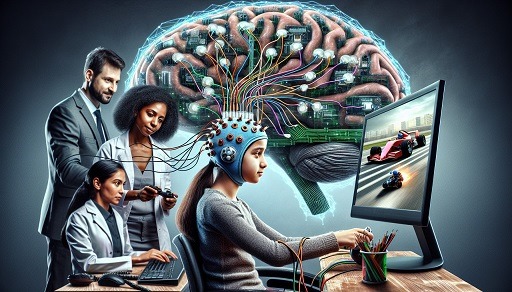Picture yourself playing a racing game, such as Mario Kart. Now, imagine controlling the game with just your thoughts. This might seem like something from a video game dream. However, it has become real. Researchers at The University of Texas at Austin have made this possible with their innovative work.
Engineers at UT Austin have developed a new brain-computer interface (BCI). This BCI helps people with motor disabilities. It also uses machine learning. This makes the BCI suitable for everyone without extensive customization. This development is a big step forward in motor disability research. Before, BCIs needed a lot of adjustments for each user, which limited their widespread use.
The research on a new, calibration-free interface has been published in PNAS Nexus. It shows promising results. Subjects wear a cap filled with electrodes. These electrodes measure the brain’s electrical signals. A decoder interprets these signals. Then, it translates them into actions in a game.
When we think about this in a clinical setting, this technology will make it so we won’t need a specialized team to do this calibration process, which is long and tedious, said Satyam Kumar, graduate student in the lab of José del R. Millán, professor in the Cockrell School of Engineering’s Chandra Family Department of Electrical and Computer Engineering and Dell Medical School’s Department of Neurology.
An expert trained the decoder used in this study. This training created a base for other users. It helped them avoid a long calibration process. The decoder was used in a car racing game and also for a simpler task: balancing a digital bar. The subjects showed impressive results. They could train for both tasks at the same time. The car racing game needed them to think ahead to make turns.
This research is only the start. It prepares the ground for more innovations in brain-computer interfaces. Next, the team will test it on individuals with motor impairments in clinical environments. They will also work on enhancing their technology to make it easier to use.
The Future of Brain-Computer Interfaces
Brain-computer interfaces are not only for gaming. José del R. Millán and his team are working on a wheelchair controlled by a BCI. This technology could improve lives of those with disabilities. It could also boost brain function for everyone.
This year, at the South by Southwest Conference and Festivals, Millán and his team presented a new breakthrough. They showed a BCI that can operate a robotic arm. This invention offers many possibilities for people with disabilities. It can help those who find daily tasks challenging because of their condition.
On the one hand, we want to translate the BCI to the clinical realm to help people with disabilities; on the other, we need to improve our technology to make it easier to use so that the impact for these people with disabilities is stronger, said Millán.
The future of brain-computer interfaces (BCIs) is promising. They could greatly affect society in ways we can’t yet measure. With more research and progress, we expect BCIs to be used in many fields soon. They have the potential to significantly improve lives.
Source: ScienceDaily










